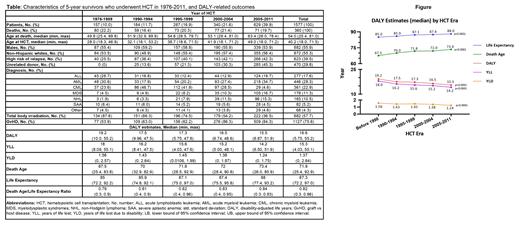Background: Although HCT is curative for many hematologic diseases, long-term survivors face a high burden of morbidity and premature mortality compared to the general population. Standard risk measures (prevalence, incidence, hazard, and standardized mortality ratios) do not convey a holistic picture of chronic disease burden because they do not account for degradation in quality of life associated with living with health conditions preceding death. DALY is an established risk measure that accounts for quality of life; it is the sum of years of healthy life lost due to disability (YLD) and years of life lost (YLL) to premature death. YLD weighs the years lived with a health condition by its disability weight (range: 0 for full health, 1 for death). Higher DALY, YLL, YLD indicate worse outcomes. We used microsimulation to estimate DALYs in 5-year survivors of HCT done over four decades, taking into consideration the changing practice of transplantation and the evolving burden of morbidity and mortality over time.
Methods: The cohort included 1577 patients who underwent HCT at age ≥18 years (y) at City of Hope in 1976-2011, survived 5y, and were followed to December 31, 2016. Vital status and cause of death (COD) were determined using medical records and the National Death Index Plus. CODs were grouped into eleven broad categories used in a Global Burden of Disease (GBD) study ( Chang et al., Lancet Public Health, 2019). All cause and cause-specific mortality risks by attained age and other risk factors were estimated from deceased patients' data. These risks were applied in microsimulation to project age at death and COD for patients known to be alive. The onset age of COD was estimated for each patient using the age-specific disease incidence rates in GBD (https://www.healthdata.org/gbd). Life expectancy (LE) at time of death was determined from the US Life Tables. YLL was calculated as LE minus age at death. YLD was calculated as age at death minus disease onset age, weighted by disability weights of the COD available at Global Health Data Exchange (https://ghdx.healthdata.org). DALY was computed as YLL+YLD. Microsimulation, performed 1000 times, provided mean YLL, YLD, DALY for each patient.
Results: Patient and treatment characteristics evolved over 35 years of HCT era ( Table). Patients who underwent HCT in the earliest era (1976-1989) had characteristics consistent with more favorable post-HCT outcomes compared to patients transplanted in later eras. From 1976-1989 to 2005-2011, there was an increase in patients who were older (median, 28y to 49y), had high relapse risk (26% to 42%), had an unrelated donor (0% to 45%), and developed chronic graft vs host disease (54% to 84%). Conversely, fewer patients received total body irradiation over time (88% to 36%). The proportion of patients transplanted for chronic myeloid leukemia declined from 24% to 5%, and there was a relative increase in patients with myelodysplastic syndrome (4% to 17%). Sex and race/ethnicity remained steady. The most common causes of death were relapse (35%), subsequent malignant neoplasms (22%), cardiovascular disease (10%), diabetes, kidney disease (10%), and infection (8%). Despite more patients with higher risk features receiving HCT in recent eras, median DALY was projected to decline from 19.2y to 15.5y from the earliest to latest HCT era (p<0.0001) ( Figure). YLL also declined from a median of 18.0y to 14.2y across eras (p<0.0001). Although YLD constituted a small portion of DALY, patients were projected to lose a median of 1.6y (1976-1989) to 1.2y (2005-2011) of healthy life due to disease-related disability. The projected age at death for the cohort (median, 67.5y to 73.4y across era) adjusted for rising life expectancy (median, 85y to 88y) suggested that survival after HCT increased in more recent HCT eras: age at death / life expectancy ratio median, 0.79 (1976-1989) to 0.84 (2005-2011) (p<0.0001).
Conclusion: Outcomes after HCT have improved during the past four decades in spite of the evolving pattern of higher risk disease and patient characteristics with time. There was notable reduction across all measures (DALY, YLL, YLD), suggesting improvements in both the quantity and quality of survival. Our results highlight the importance and utility of DALY when characterizing health outcomes after HCT, as it provides a more comprehensive assessment of the changing pattern of efficacy associated with transplantation.
Disclosures
Al Malki:CareDX: Consultancy; NexImmune: Consultancy, Research Funding; Incyte: Consultancy, Membership on an entity's Board of Directors or advisory committees, Research Funding; Gilead: Consultancy, Membership on an entity's Board of Directors or advisory committees, Research Funding. Nakamura:Leukemia & Lymphoma Society: Other: grant reviewer; NCTN Lymphoma Steering Committee: Membership on an entity's Board of Directors or advisory committees; Sanofi: Consultancy; Miyarisan: Research Funding; NCCN: Other: guideline panel for HCT; Mt. Sinai: Other: Acute GVHD; BMT CTN Steering Committee: Membership on an entity's Board of Directors or advisory committees; Blue Bird: Consultancy; Napajen: Consultancy; Omeros: Consultancy; Jazz Pharmaceuticals: Consultancy, Other: research collaboration; International Consortium: Other: consortium chair.


